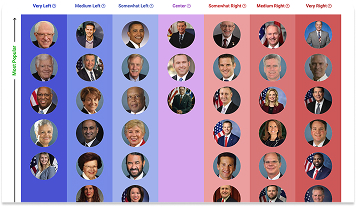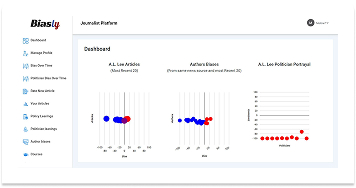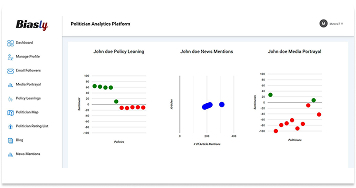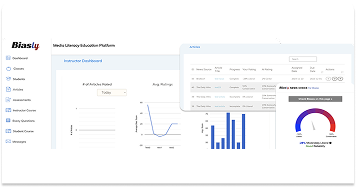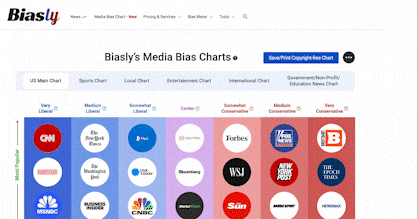Bias Meter
Extremely
Liberal
Very
Liberal
Somewhat Liberal
Center
Somewhat Conservative
Very
Conservative
Extremely
Conservative
-100%
Liberal
100%
Conservative
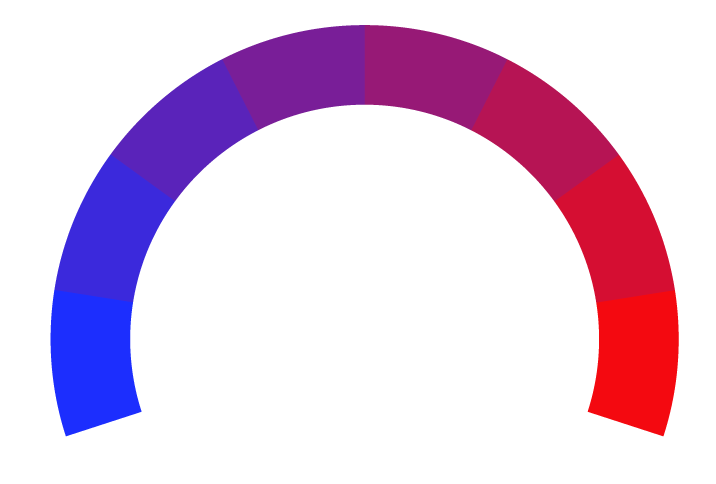
Biasly determines media bias ratings through a dual-layered approach combining artificial intelligence and analyst review. The platform’s proprietary bias detection engine, Bias Meter, evaluates sentiment, policy position alignment, and language framing across thousands of data points in news articles. Analysts then verify and interpret the AI’s findings, providing additional context where needed. Learn more
- Profile
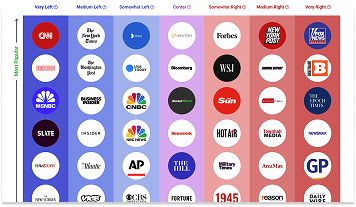
AP News on the media bias chart
AP News has a Bias Score of -18% Somewhat Left which is based on a variety of factors including its policy and politician leanings, article ratings, and the use of biased language. Its Reliability is rated as Good, and additional analytical insights are available in the other tabs.
- Bias Rating
-18% Somewhat Left
- ReliabilityPolicy Leanings
-2% Center
Extremely
LiberalVery
LiberalModerately
LiberalSomewhat Liberal
Center
Somewhat Conservative
Moderately
ConservativeVery
ConservativeExtremely
Conservative-100%
Liberal100%
Conservative
Average Reliability
*Our bias meter rating uses data science including sentiment analysis, machine learning and our proprietary algorithm for determining biases in news articles. Bias scores are on a scale of -100% to 100% with higher negative scores being more liberal and higher positive scores being more conservative and 0% being neutral. The rating is an independent analysis and is not affiliated nor sponsored by the news source or any other organization.
Politician Portrayal55% negative
Continue For Free
Create your free account to see the in-depth bias analytics and more.
By creating an account, you agree to our Terms and Privacy Policy, and subscribe to email updates.
Policy Leanings Analysis
Policy | Bias score |
|---|
AP News Editorial Patterns
AP News’s coverage of political topics often reflects a Somewhat Left bias, with consistent patterns in phrasing, source selection, and thematic focus that is Lean Left. While the publication demonstrates journalistic standards in many of its reports, the choice of issues, framing, and word usage can indicate a political slant. This content analysis examines how AP News handles liberal and conservative issues and evaluates its language choices and editorial tendencies.
Coverage of Liberal vs. Conservative Topics
AP News’s articles include left-leaning topics such as abortion and LGBTQ+ rights. When visiting their website and going under the “U.S.” tab, you can find those labeled as sections. This implies extensive coverage of these topics to the point where they require their own category. When discussing abortion, AP does not exhibit biased tones or language. Instead, they often provide a neutral coverage of the story, sticking solely to facts. Contrastingly, LGBTQ+ and other social issues provide a sympathetic and supportive tone.
Right-leaning topics also get extensive coverage, primarily about immigration and President Donald Trump’s administration. These two topics also have their own category under the “U.S” tab. AP News tends to provide neutral and fact-based coverage of Immigration stories. However, some headlines display subtle bias, such as in this article. While factually correct, words such as “strips” carry a negative connotation. Further, the title states that the breaks are taken from “thousands of students,” implying that any student can be impacted. However, the title omits that the breaks were taken from immigrant students who are in the country illegally.
Recognizing political bias often comes down to word use and tone. An article can present all the facts as they are, but can still be biased. For example, if a left-leaning source publishes an article about a Black Lives Matter demonstration, they would use words such as “equality,” “justice,” and “protest”. These are meant to provide a righteous and supportive tone to the demonstrations. Comparatively, if a right-leaning source publishes a similar article, it might use words such as “riot,” “violence,” or “chaos. These words promote a negative and anarchic tone to describe the demonstrators.
Policy and Issue Framing
When covering gender rights, AP News often references inclusivity and representation, supporting movements for expanded legal protections. This aligns with a Somewhat Left media bias, especially in Utah, where local culture tends to be more conservative. Similarly, coverage of environmental issues reflects an urgency consistent with climate advocacy narratives — often featuring voices from scientists, community leaders, and activists in favor of green legislation.
In contrast, issues like gun rights, border security, or religious liberties — typically associated with conservative platforms — are covered in a more cautious or critical tone. These stories are often contextualized through the lens of their impact on marginalized groups or framed as polarizing.
Even in neutral coverage, phrasing choices shape perception. Articles will describe liberal proposals as “expanding access” or “strengthening protections,” while conservative legislation may be described as “imposing limits” or “rolling back rights.” This consistent choice of words reflects an editorial direction that, even unintentionally, can contribute to bias in news media.
Coverage and Relevance
AP News’s reporting often touches on key issues about political discussion. They often cover the economy and significant business transactions. For example, they provide a live tracker of any news relating to Donald Trump’s tariffs. They also provide international coverage, including updates about the Israel-Gaza conflict, the Russo-Ukrainian war, and sections about major regions such as China, Latin America, Africa, and Europe.
AP News also provides a fact-checker service, where they fact-check statements made by government officials or articles. However, the majority of these fact-check articles are directed towards Republican-associated politicians, such as Donald Trump, Robert F. Kennedy Jr., and Tulsi Gabbard.
Readers who wish to explore further how AP News compares with other publications can visit Biasly’s Media Bias Chart to analyze tone and word choice in real time.
AP News Bias Analysis
AP News is one of the largest news media organizations in the world. They claim that four billion people see news from AP News every day. They also say that they produce 5,000 individual pieces every day, and they have 230 locations spanning across 91 countries with customers in 150 countries. They boast about having extensive, nonpartisan, and fact-based coverage throughout the world. According to a YouGov poll, AP News is the seventh most trusted news source among Americans.
AP News plays a significant role in shaping the public’s perspective about events around the world. Due to their high trust and reputation as one of the world’s leading news media organizations, it is necessary to identify any biases that they have. This article delves into AP News’s tendencies and history to identify any biases that might be present.
Is AP News Biased?
Based on Biasly’s evaluations, AP News is rated as Somewhat Left.
By examining content patterns and the broader context of media influence, we aim to offer a balanced perspective on AP News’s political bias—and contribute to the ongoing discussion about bias in the news.
How Does Biasly Rate News Sources?
Biasly uses proprietary algorithms and a team of analysts to provide comprehensive bias evaluations across thousands of news outlets. Over 200,000 articles from more than 3,200 sources have been analyzed to identify the most accurate and unbiased stories.
Biasly assigns each outlet three key scores:
- Reliability Score – Reflects factual accuracy
- AI Bias Score – Generated via natural language processing
- Analyst Bias Score – Assessed by human political analysts
These scores are based on seven core metrics: Tone, Tendency, Diction, Author Check, Selection/Omission, Expediency Bias, and Accuracy. These elements help analysts and algorithms evaluate the political attitude conveyed by each article.
Biasly’s Bias Meter ranges from -100% (most left) to +100% (most right), with 0% indicating neutrality. The system evaluates individual articles based on political terms, policies, figures, and sentiment to calculate precise bias ratings.
Is AP News Politically Biased?
AP News earns a Somewhat Left rating for its AI Bias Score and a Somewhat Left for its Analyst Bias Score. The Analyst Bias Score is generated by reviewers from liberal, moderate, and conservative backgrounds. Analysts reviewed 15 AP News articles and noted preferences in areas like coverage of liberal politicians and policy topics such as abortion rights and clean energy. However, the paper maintained objectivity on topics like education and national security.
To identify political bias, one must first look at the demographics of their audience. According to AP News’s ‘Audience’ page, the majority of AP News’s viewership is from the United States. Thus, it is likely that American-related topics will take precedence. This can be seen through AP News’s home page, which displays photographs, articles, and short videos. The majority of the media shown there are related to football, the current administration, or American entertainment media.

Source: AP News
The same audience page also shows that the majority of their readers are male. According to a Pew Research Center poll, men are more likely to be right-leaning than left-leaning.
But demographics can also show so much. Bias comes in many forms, such as wording, omission, and general tone. Thus, it is necessary to evaluate AP News for signs of bias and reliability to better understand their political bias.
Analysis of Bias in AP News Online Articles
AP News covers global events extensively. However, they generally cover US events more often than they do any other country. Most American news sources have some sort of bias, however big or small.
To evaluate this, we can analyze selected AP News articles through several of Biasly’s bias rating criteria: Tone, Tendency, Author, Diction, and Expediency Bias.
- Tone: Emotions conveyed in the article
- Diction: Vocabulary used in the article
- Author: History and trend of the writer
- Tendency: Patterns or trends that the writer’s other works follow
- Expediency Bias: Images or phrases that are meant to catch the reader’s attention

Source: AP News
We analyzed one such article, shown above. The article, which follows Trump’s impacts on the US economy, presents no visible forms of bias.
There is little to no expediency bias present. Two images are shown, neither of which is inherently negative or positive. The title does not use potentially biased language, opting to stick to fact-based language. One might argue that there is the occasional lapse in neutrality, such as in the following quote from the article.
“‘I think they did it purposely,’ said Trump, who has yet to offer statistical evidence backing his theory. Revisions are a standard component of jobs reports and tend to be larger during periods of economic disruption. “
This passage refers to Trump alleging that the Bureau of Labor Statistics purposefully overestimated the number of jobs created during Joe Biden’s last two years in office. One might say that the author is trying to defend Biden’s work and the numbers presented by the bureau. However, this can be explained away that the author is just attempting to give the benefit of the doubt and explain the statistical process.
There is no clear biased language in the article. The tone presented is also neutral, sticking to unbiased language. The article does not negatively portray the president beyond providing statistics that might refute the president’s words. These statistics, however, are from credible sources and are considered factual and relevant. Thus, it is unlikely that they are a sign of bias.
When analyzing the author of the article, Josh Boak, we found that he has a mixed history. Boak’s LinkedIn page details his work experience at the Toledo Blade, Chicago Tribune, researcher for the book “Obama’s Wars,” the Fiscal Times, Politico, and finally AP News. The Toledo Blade and Chicago Tribune provide local news coverage and rarely go into national politics. “Obama’s Wars” is a book that was largely critical of former President Barack Obama’s handling of wars in the Middle East. The Fiscal Times was primarily an economy-based news source. His final position before his work at AP News was at Politico, which Biasly’s Media Bias Chart rates as ‘Somewhat Left.’ Working at Politico might suggest a left-leaning bias; however, research for “Obama’s Wars” might suggest a right-leaning bias.
Boak has very little social media presence. We were only able to find Boak’s X account, where he rarely posts. When he does post, however, it is only photos relating to his position as White House correspondent. There is no sign of bias.
@bts_bighit introduced at White House briefing room. pic.twitter.com/gJCbVCmJMp
— Josh Boak (@joshboak) May 31, 2022
Ultimately, the article does not present bias in any meaningful way. When analyzing other articles, they generally follow a similar trend.
We analyzed another article through a similar process. The tone is neutral and informative, opting not to use inherently positive or negative words to describe policies. It could be argued that the article gives leniency to the Democratic Mayor of Washington, D.C., Muriel Bowser. However, this leniency is unlikely to be indicative of bias, as they use credible statistics and do not outright give credit to Bowser. The author, Will Weisser, does not have a significant social media presence and only lists AP News on his LinkedIn page.
We were unable to find any clear forms of expediency bias in AP News articles.
AP News’s bias, however, may have varied over time. Articles during the first year of Trump’s second term tend to be unbiased. But an article from 2023 presents more bias.
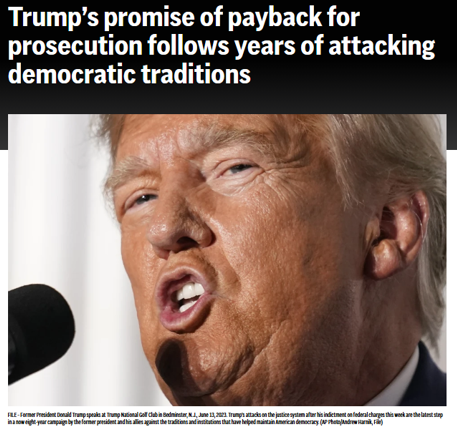
Source: AP News
First, let us analyze expediency bias. Among the first things a reader would see of this article is the featured image. The featured image potentially presents a negative view of Trump. The still frame of Trump mid-sentence is unflattering and gives an aggressive view. Looking at the title, we find phrases such as “attack on democratic traditions” or “payback for prosecution.” These present an unlawful view of Trump, portraying him as anti-democratic and someone who is attempting to break down democracy. A phrase in the first paragraph also states that Trump supporters were going through a “familiar routine of mounting a victimhood defense.” Stating the defense as a “victimhood defense” implies that claims of victimhood are unfounded. Stating that it is a “familiar routine” implies that he has regularly done such unfounded defenses. Overall, expediency bias presents a negative view of Trump.
The tone and diction follow suit. The article uses words such as “attack” and “payback” to portray Trump as aggressive and vengeance-seeking. The article uses quotes from historians to back this claim up, who also take an anti-Trump stance, using words such as “authoritarian” and “abuse the office.” Using words directly from the article, such as the following quote, it seems that they are taking a direct stance against Trump.
“Trump’s attacks on the justice system are the latest step in a now eight-year campaign by the former president and his allies against the traditions and institutions that have helped maintain American democracy.”
To summarize, AP News does not show any significant bias post-Trump’s second election. However, an argument could be made that bias was present in the reporting before the election.
Who Owns AP News?
AP News was founded in 1846 by five New York City newspapers: the New York Sun, New York Herald, New York Courier and Enquirer, Journal of Commerce, and New York Evening Press. It would later be joined by the New York Times and the New York Tribune. It was organized by the publisher of the New York Sun, Moses Yale Beach. According to their ‘Our People’ page, it is organized as a not-for-profit cooperative between partner news agencies.
AP News has two governing bodies: the board of directors and the executive leadership team. The board of directors is chaired by Gracia C. Martore (pictured above) and contains senior leadership of other news organizations. The board most notably features William Lewis, CEO of the Washington Post. The executive leadership team is led by Daisy Veerasingham, who is CEO and President of AP News.
AP News states that their goal is to provide an unbiased and factual reporting of events around the world. Their goal is not to make a profit, but rather to spread news efficiently. Thus, they have low net income relative to other news organizations, according to an AP News article.
Who Funds AP News?
As a not-for-profit news cooperative, AP News is funded primarily through the fees it collects from thousands of member news organizations, broadcasters, and digital publishers that license its reporting. These membership and licensing payments make up the majority of its operating revenue and allow the outlet to produce large volumes of international, national, and local reporting without relying on traditional shareholders or private owners seeking profit.
Additional revenue comes from commercial photo, video, and data services, along with limited advertising on AP’s digital platforms. Because its funding model is broad and distributed across many member organizations rather than tied to a single benefactor, the risk of financial influence over editorial decisions is relatively low. However, some critics note that the cooperative structure means AP must balance the expectations of its member outlets, which can span the political spectrum. While this dynamic does not indicate partisan bias, it can shape editorial priorities toward broadly acceptable, non-polarizing coverage. Overall, AP’s diversified, service-based funding model supports its mission of independence and reduces direct political pressure compared to for-profit or donor-funded news organizations.
How to Evaluate Bias
Although Biasly rates AP News as Somewhat Left, it’s important to remember that bias can vary from article to article. AP News also covers a conservative-leaning state with objectivity on many issues, from state legislation to social developments. This complexity underscores the importance of examining each article individually. So, let’s learn how to evaluate media bias.
Recognizing media bias requires awareness and critical thinking. Often, readers trust news sources that affirm their existing beliefs—a psychological tendency known as confirmation bias. This makes it harder to identify slanted narratives or one-sided reporting.
To combat this, it’s essential to challenge your assumptions by consulting multiple viewpoints and verifying news through third-party analysis. Tools like Biasly’s media bias ratings allow readers to compare the same news story across the political spectrum.
Ultimately, bias isn’t always a matter of what is said—it’s also about what is left out, how topics are framed, and which stories are chosen for coverage. Learning to recognize these patterns can help readers make more informed decisions and develop greater media literacy.
To start comparing news outlets and gain a better understanding of bias, sign up for Biasly’s Media Bias & News Analytics Platform to see how stories vary between sources.
AP News Reliability Analysis
Is AP News Reliable?
AP News prides itself on its reliability and accuracy. Generally, the public shares this perception. An aforementioned YouGov poll placed AP News as the seventh most trusted news source. The public perceives AP News as reliable for factual reporting, but are they truly reliable?
How to Evaluate Reliability?
Reliability refers to how trustworthy or accurate a news source is. If we can’t trust what we read, then continuing to consume content from that outlet serves little purpose. So how do we evaluate a news outlet’s reliability?
There are several potential measures of reliability to look out for when trying to determine whether a media source is reliable or not. Red flags for an unreliable article can include the presence of wild, unsubstantiated claims, facts dependent on other unreliable sources, heavy use of opinionated language, and more. In contrast, hallmarks of a reliable source include:
- Absence of subjective language
- Citing credible sources (e.g., .gov, .edu, academic references)
- Verifiable facts and statistics from multiple outlets
- Use of primary sources, like interviews or transcripts
- Consistency with coverage across other platforms
Biasly’s reliability scores incorporate these elements in evaluating media outlets.
So How Does AP News Fare in Its Reliability?
The political reliability index developed by Biasly assesses both accuracy and trustworthiness. AP News currently holds Good Reliability Score, which is calculated as a weighted average of:
- Fact Analysis Score – Evaluates the accuracy of claims, facts, and evidence.
- Source Analysis Score – Assesses the number, diversity, and credibility of sources and quotes used.
AP News’s Source Analysis Score is Average at 50% Reliable. This suggests moderate trustworthiness in its sourcing practices. The score is AI-generated and considers quote length, frequency, diversity, and quality.
The Fact Analysis Score of AP News is Good at 87% Reliable. This further shows how well AP News supports its claims, addresses selection and omission bias, and presents verifiable evidence.
While AP News leans toward factual reporting, occasional lapses—such as unbalanced viewpoints or incomplete data—can affect its reliability rating. These nuances emphasize the importance of analyzing individual articles.
AP News’s Accuracy and Reliability
According to Biasly’s analysis, AP News maintains Good Reliability Score, but individual articles may vary significantly. Let’s dive into the details.
Political orientation plays a crucial role in how audiences perceive reliability. AP News has been accused of favoring a liberal narrative, potentially at the expense of factual reporting. To validate such claims, it’s essential to analyze whether the publication backs its assertions with sufficient evidence and diverse viewpoints.
Two common types of bias that affect factuality include:
- Selection Bias – Highlighting or omitting stories to fit a particular narrative.
- Omission Bias – Leaving out differing perspectives or relevant details to skew perception.
Biasly’s accuracy ratings use a scale from 1% (least accurate) to 100% (most accurate). Factors include the presence of supporting evidence, internal and external reliable sources, and balanced viewpoints.
For instance, Biasly gives Fox News a “Medium Right” bias analysis score and a “Good” reliability score. Biasly used articles such as this 2021 article discussing Trump’s launch of a communication platform that would later evolve into Truth Social. Key factors that went into determining this bias rating include the omission of opposing views and the sources used. Most of the sources and quotes taken in the article were from right-leaning sources or directly from Trump’s team. The article did not provide enough coverage of the reason Trump was banned from Twitter and Facebook, with only one mention of the events on January 6th, 2021. Because this event was used as the justification for the bans, it is important to mention it more.
We will take a closer look at more examples like this below to provide a further investigation into the reliability of AP News’s articles. This will include its use of selection bias, omission bias, and the quality of its sources and the facts it uses.
Analysis of Reliability in AP News’s Online News Articles
Reliability can sometimes be a difficult matter to approach. Where one might believe a source is unreliable, another might believe it is the most reliable. AP News prides itself on its reliable and fact-based reporting. But is this truly the case?
The goal of this section is to analyze AP News’s reliability. To do so, we will analyze the sources used, the facts presented, what is not presented, and what is highlighted in the article. Synthesizing these elements will allow us to understand how reliable AP News is for factual and objective reporting.
Quality of Sources and Facts Used
AP News tends to use multiple credible sources when reporting. They tend to use direct quotes, credible sources, and substantiated facts. They also tend to include opinions of both sides on a debate, clearly noting between factual and opinion statements.
For example, this article, published by AP News, discusses the Justice Department investigating New York Attorney General Letitia James. This contains 9 direct quotes, only one of which is a long-form quote.
“‘Weaponizing the Department of Justice to try to punish an elected official for doing her job is an attack on the rule of law and a dangerous escalation by this administration,’ Lowell said.”
Other quotes are either short phrases or keywords. Still, these phrases and quotes capture the essence of the arguments. Additionally, they do not add excess words nor seem to frame the quotes in a biased way. For example, the following quote from the article contains both a keyword quote and a short phrase quote. For context, the following passage is discussing James’s election campaign for attorney general in 2018.
“She fixated on Trump during the 2018 campaign, branding him as a ‘con man’ and pledging to shine a ‘bright light into every dark corner of his real estate dealings.’ “
While there is much left to be desired for long-form quotes, the article does not frame the short quotes negatively. They stick to factual statements for context about the quote.
Now, let’s analyze the sources used. The article uses 13 links, all of which lead to AP News articles. The article includes the following sources, links excluded.
- Anonymous Informant A, “a person familiar with the matter”
- Anonymous Informant B
- Anonymous Informant C, “a person familiar with the matter”
- Donald J. Trump, statements made at a rally
- Abbe D. Lowell, James’s personal attorney, making a statement
- Letitia James, New York Attorney General, statement during campaign
- Court documents, documents of lawsuits between New York and Donald J. Trump, and New York and the National Rifle Association
- Judge’s Ruling, document detailing a Judge’s ruling against Trump, and document detailing a judge’s ruling against the National Rifle Association
- Bond Statements, records, and statements from a bond company
- FBI Director Kash Patel, statements regarding the investigation into James
- Mortgage forms, documents regarding the mortgage for James’s niece
The article exclusively cites primary sources to report on the topic, which is a good indicator of reliability. Many of the sources are legal documents such as lawsuits, judge rulings, or bond statements. Others are statements made by either side of the debate, and thus are reliable for depicting opinions. The article also uses anonymous sources that are “familiar with the matter.” We are unable to independently verify if these sources are credible. AP News‘s “Telling the Story” page states their rules for anonymous sourcing. If these rules were followed, then it is likely that these anonymous sources are connected, in some way, to the investigations. Thus, they can be a semi-reliable source, but we advise the viewers to consider the whole situation.
Ultimately, the sources and facts presented in this article are fairly reliable, credible, and relevant.
Selection and Omission Bias
AP News presents credible and reliable sources and facts in their articles. However, selection and omission bias are more difficult to detect. Thus, this section will analyze such biases.

Source: AP News
This article, published by AP News, discusses concerns regarding Trump’s nominees to federal judicial positions. The article does a good job of avoiding selection and omission bias. Notably, the article presents both sides of the debate equally, with perhaps a slight lean to the right.
The article takes quotes from advocates from both sides of the debate. One quote is from a legal director for the anti-abortion group, SBA Pro-Life America. The quote states that the group “look forward to four more years” of appointees with similar views. Another quote comes from the president of the pro-abortion group, Reproductive Freedom for All. the quote argues Trump is attempting to “distance himself from abortion” while “appointing anti-abortion extremists.” It presents both quotes equally.
The article also takes a quote from a White House spokesperson. The quote gives direct support for the nominees. However, the article notably lacks quotes from official members of the Democratic Party. This could be seen as a form of omission bias, as it does not give a voice to the official party, the same way it does to the Republican Party. However, this is skeptical and is not itself indicative of bias.
The article does not provide surrounding context or information relevant to the quotes, other than the speaker’s name and position.
Another article addresses a lawsuit between the state of California and the federal government over California’s National Guard being deployed without the governor’s consent. The Democratic government of California has raised many objections against the Republican federal government. The article, while presenting the facts, leaves much to be desired when presenting the arguments.
The article extensively covered the Trump Administration’s arguments. They use quotes from Trump and other government employees who are sympathetic to Trump. The article provides the administration’s justifications for their actions and cites laws that they used. However, the article rarely mentions California’s objections and arguments. It only mentions one of California’s arguments. Meanwhile, they present the judge’s opinions on the matter, which tend to lean in favor of California.
The article provides arguments for both sides of the debate. Still, the article provides more coverage of the Trump Administration’s arguments than it does of California’s arguments.
So, is AP News Reliable?
Overall, AP News can be considered to be an outlet that is very reliable. It demonstrates a consistent goal of journalistic integrity and typically supports claims with sources and quotes. Occasional omissions and framing bias do appear, particularly on culturally sensitive or partisan issues.
As media literacy improves, readers can more easily detect issues with selection bias, omission bias, and factuality. To strengthen your ability to assess reliability across the political spectrum, use the News Bias Checker to compare how multiple outlets report the same story.
This empowers you to consume more accurate, balanced, and dependable news.
Additional Insights
News Source Comparison
AP News is among the top news sources in the world. They cover international, national, and occasionally local events. Because of their reputation, they are often cited among other significant news sources, such as Reuters, BBC, CNN, and the Washington Post.
Notable Contributors and Authors
AP News does not boast any notable authors. Still, their organization has partnerships with other news sources, most notably with The New York Times. Many significant investors are on the board of directors. This includes CEOs of companies such as the Knight Foundation, Adams Publishing Group, the Washington Post, Digital and Savvy, MAP Strategies Group, Lee Enterprises, and Advance. Sources may purchase articles from AP News to publish on their sites.
Related Tools and Resource Pages
To better understand how AP News fits into the broader media landscape, we recommend exploring these helpful resources:
- Media Bias Chart: See where AP News ranks among hundreds of media outlets across the political spectrum.
- Political Bias Chart: Visualize political slants of news sources across various policy areas.
- Journalist Bias Analytics Platform: Explore how individual journalists contribute to bias within their publications.
- Politician Bias Analytics Platform: Compare how politicians are framed differently by AP News and other outlets.
- Media Literacy Education Platform: Learn how to critically assess media sources, bias techniques, and news reliability.
Frequently Asked Questions
AP News is rated as Somewhat Left based on Biasly’s media bias algorithm, which assesses sentiment, article framing, and policy favorability.
AP News is not widely known for promoting fake news, and they promote themselves as factual and unbiased. Nonetheless, Donald Trump called them “radical left” and called one of their employees a “radical left lunatic,” according to a video published by the Forbes Breaking News YouTube account. These remarks were about Trump renaming the ‘Gulf of Mexico’ to the ‘Gulf of America.’ However, AP News still referred to the body of water as ‘Gulf of Mexico.’
Biasly uses a combination of AI sentiment analysis and human analyst review to assess tone, fact accuracy, source quality, and media bias indicators. Learn more on our Bias Meter page.
They are generally reliable for factual reporting. Their articles use credible and reliable primary sources and direct quotes. Furthermore, the aforementioned YouGov poll found that they are among the most trustworthy news sources.
Ratings are based on recent news using data science and A.I. technology.
Military Spending
| Date | Sentiment | Associated Article | Snippet |
|---|---|---|---|
| 08/25/2019 | 75% For | Trump Family Detentions Flores Agreement (link) | So, of course, the Trump administration is doing the opposite in a baldfaced |


























